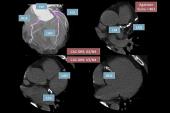Statin Decisions Gain From Scoring of Coronary Artery Calcium: MESA
CAC should be checked like lipid values to help guide patient-specific decision-making, said Jaideep Patel.

Coronary artery calcium (CAC) scoring can aid statin decisions alongside traditional risk factors among people at intermediate risk of atherosclerotic cardiovascular disease (ASCVD), according to a new analysis.
“The use of CAC scoring was associated with significant improvements in the reclassification and discrimination of incident ASCVD and may therefore be useful as an adjunct to risk-enhancing factors to identify individuals with intermediate risk of ASCVD who would benefit from statin therapy,” write the authors, led by Jaideep Patel, MD (Virginia Commonwealth University Medical Center, Richmond, VA).
“You maybe treat it like you check a lipid, for example, on somebody,” Patel told TCTMD. “[A zero score] shouldn't necessarily give a heightened sense of perceived lower risk, . . . but that doesn't necessarily mean that you shouldn't continue to do all the things that keep you healthy like not smoking, being active, following a healthy lifestyle, Life’s Simple 7s, maintaining a normal weight and managing your diabetes, things of that nature.”
The data represent “yet another example of how the power of patient-specific atherosclerosis medical management, or patient-specific atherosclerosis by calcium scoring in this case, helps identify patients who are going to derive benefit from medical therapy and helps also identify patients for whom medical therapy may be unnecessary, at least at intermediate-to-10-year follow-up,” said Jonathon Leipsic, MD (St. Paul’s Hospital, Vancouver, Canada), who commented on the study for TCTMD.
“It's this personalization of care that I think we're starting to see as really helpful rather than guiding medical therapy strictly on population-based risk factors, which I think serves the population reasonably well as a whole but certainly doesn't allow for the titration of medical therapy on an individual level,” he continued.
CAC in MESA
For the study, published online recently in JAMA Cardiology, Patel and colleagues included 1,688 patients at intermediate risk of ASCVD from the MESA study (57.8% men; mean age 65), with 42.8% having a CAC score of zero.
Over a median follow-up of 12 years, having a CAC of zero was associated with an unadjusted incidence rate of ASCVD of less than 7.5 events per 1,000 person-years for all individual risk-enhancing factors—except for ankle-brachial index (ABI; 10.4 events per 1,000 person-years)—and combinations of risk-enhancing factors, including those with at least three.
Adding individual and combined risk-enhancing factors to the traditional risk factor assessment led to improvement in the area under the receiver operating curve, but the use of CAC scoring was associated with the greatest improvement in predicting ASCVD events (C-statistic 0.633 vs 0.678). For incident ASCVD, adding CAC to the pooled cohort equation as a continuous variable resulted in the highest net reclassification value (C-statistic 0.067).
Based on these data, CAC scoring “should get a boost,” Patel said. The study is the first to show that “the risk-enhancing factors we did have are able to predict risk to about 7.5%, most of them just kind of cross the threshold. . . . So we know that if you have them, your risk is probably sufficiently high enough to say you should start a statin. But the discordance comes where you apply coronary calcium and the calcium is zero, which puts you at an even lower risk of an event at the 10-year mark. That's where we say: why are we guessing, should we put calcium ahead of these risk enhancing factors? That would be a logical next step.”
Current guidelines support calcium scoring for patients deemed to be at intermediate-to-high-risk “then really titrating medical therapy based on the calcium score, with a calcium score of greater than 100 embedded in the cholesterol guidelines,” Leipsic said. “But some still haven't adopted it, and I think there's a hesitancy to do so because of the perception that it's unnecessary testing or [because] some people still revert back to population-based risk factors. But there's clearly power in understanding the individual burden of atherosclerosis.”
The specific finding that risk enhancing factors were not necessarily coordinated with CAC in patients with low ABI was “not necessarily surprising because ABI measures are also a direct measure of atherosclerosis similar to how CAC is,” Patel said. However, “what was surprising was that the prevalence of coronary calcium [zero score in women] is 50%. This kind of steps along the lines of ‘women present differently,’ and I know there's been rumblings or talks about whether or not we need different set of sex-specific guidelines for women.”
Applying the CAC score for statin decisions can also help with disutility, Patel continued. “You can prescribe medications all you want. The question is if still someone will take it. We know there are high rates of disutility. We know that some people suffer from statin-related side effects. So this may be one way to kind of mitigate that.”
Additionally, as “people respond to their coronary calcium scores,” when patients can physically view their scans and see the calcium, “they are more likely to take their medication and that translates into improvements in lipid values, improvements in other markers of health like blood pressure, weight, things like that,” he said.
Unknowns
Open questions remain with regard to when to rescan patients for CAC, especially those with risk-enhancing factors, as well as how CAC can predict risk in South Asians, as they were not included in the study, Patel said. “At the very least, I think this research should help spur a specific conversation [about] should we start with CAC testing instead of enhancers when assessing adults at intermediate risk by the pooled cohort equation.”
Leipsic said the biggest unknowns with regard to CT angiography include how it will be adopted into practice assuming the long-awaited update to the US chest pain guidelines give a class I recommendation. He asked: “Will the field be able to respond to the class I indication? Will we have enough people trained? Will we have enough access to cardiac CT? Will we be able to deliver the care with quality and efficiently and in a meaningful way? Will we be able to understand better how to use atherosclerosis measures? Should we be quantifying plaque or should we just rely on more crude measures to guide medical management such as the presence of plaque or the calcium score?”
For now, in someone at intermediate risk with a zero CAC score “the evidence would suggest that you need to treat a very large number of patients to reduce an event, and so I think most people would suggest that you can deintensify therapy in those cases,” Leipsic said. “Unless it's a very young patient with a high cholesterol, where they may not have developed calcium yet but they may still be at risk. But if you have an intermediate-risk male patient at the age of 55 without calcium, most people would defer medical therapy and the evidence would support that.”
Yael L. Maxwell is Senior Medical Journalist for TCTMD and Section Editor of TCTMD's Fellows Forum. She served as the inaugural…
Read Full BioSources
Patel J, Pallazola VA, Dudum R, et al. Assessment of coronary artery calcium scoring to guide statin therapy allocation according to risk-enhancing factors: the Multi-Ethnic Study of Atherosclerosis. JAMA Cardiol. 2021;Epub ahead of print.
Disclosures
- Patel and Leipsic report no relevant conflicts of interest.





Comments